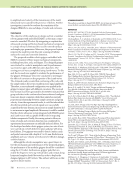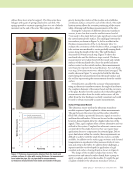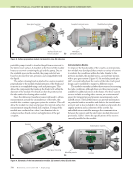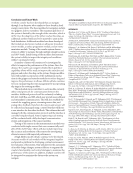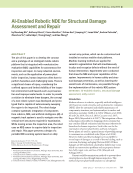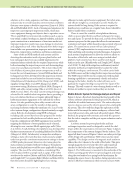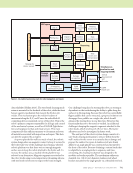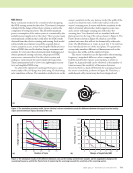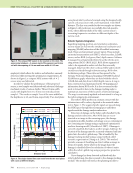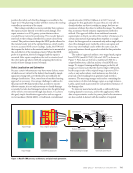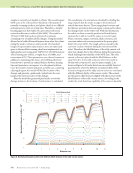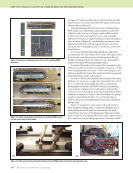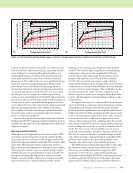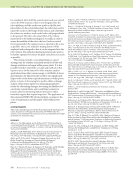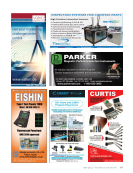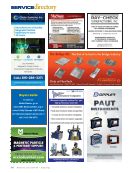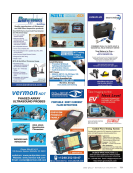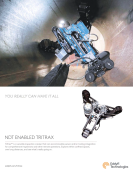ME TECHNICAL PAPER w modular robotic gripper for tubular components 716 M A T E R I A L S E V A L U A T I O N • J U L Y 2 0 2 1 productivity. Meanwhile, an out-pipe robot inspects tubular structures from the outside, thus allowing the plant to continue its operation. However, the main challenge facing the application of out-pipe robots is their limited mobility. For example, out-pipe robots must attach themselves to the structure using either friction or magnetic force (Lee et al. 2014), or use other methods like vacuum- or thrust-based systems and, at the same time, maneuver around other obstacles. Because an out-pipe robot does not require a plant to be shut down, assuming that the robot can traverse obstacles on the structure, this solution becomes the most cost-effective method of inspection. Multiple wheel-based out-pipe inspec- tion robots have already been developed (Xu and Wang 2008 Kawasaki et al. 2008). However, the disadvantage is that they can only be placed on a single pipe at a time. Once these robots are placed on a tube, workers will have to disassemble it before attaching it to another pipe. This exercise can be time-consuming and ineffective if a large tubular structure needs to be inspected. Therefore, the authors adopted a bioin- spired approach and proposed a robot with modular grippers with integrated noncontact ultrasound sensing elements to climb on vertical and horizontal surfaces using friction-based mobility. Thus, the objective of this study is to design and test a modular robotic gripper with embedded electromagnetic acoustic transducers (EMATs) as the main component of a versatile lizard-inspired tube inspector (LTI) robot (Marvi et al. 2020) (see Figure 1). Ultrasonic testing (UT) is the most effective nondestruc- tive testing (NDT) method that can be integrated with robotic platforms for inspecting tubular components (Liu and Kleiner 2013). Robotic ultrasonic inspection is sensitive to both surface and subsurface discontinuities and different UT techniques may be used for different types of tests. For example, UT can be used to evaluate surface rust, thickness, and deficiencies in the structure being tested. Furthermore, the size of the equipment required for UT is relatively small, which results in light payload for the robot. Contact UT based on bulk or guided waves is time-consuming and requires prepared surfaces with adequate couplants for point-by-point scanning, whereas EMATs are noncontact ultrasound trans- ducers that can effectively solve this problem. Because EMATs do not need a couplant, they can excite ultrasound waves through extreme temperatures and in remote locations (Salzburger et al. 2012). An EMAT works by using a coil that carries a current when a magnet is placed over the coil, a Lorentz force, which transmits the ultrasound wave through the material, is created. These transducers can generate different types of ultrasound waves, such as bulk, Lamb, and shear horizontal waves (SH waves), depending on the magnet-coil configuration (Lee et al. 2014). The generated waves can be used to detect and measure defects, cracks, and other discontinuities by transmission and reflection analyses. In addition, EMATs are less sensitive to surface conditions if the liftoff (the gap between the transducer and surface) is maintained within an acceptable range (Green 2004). These advantages make EMATs the perfect candidates for integra- tion into robotic platforms for inspection purposes. Park et al. (2002) described two mobile robotic inspection systems using different types of EMATs. They pointed out that some pipelines transport hazardous chemicals therefore, automation of discontinuity detection using the proposed robotic system minimizes the danger of human exposure to such a harmful environment. Kwon and Yi (2012) designed a caterpillar-based pipeline robot capable of inspecting 80 to 100 mm indoor pipelines. Another highly mobile robotic ultrasonic inspection system was proposed by Lee et al. (2014). With the help of a two-module mobile robotic platform, SH waves were applied with additional signal- processing methods to inspect pipe structures. Ren et al. (2017) developed a machine that uses an EMAT as the primary source for conducting ultrasound waves to detect discontinuities in materials. They also developed a special EMAT that could use high-sensitivity Lamb waves and SH waves simultaneously. Lissenden et al. (2017) developed a novel robotic system for crack detection in dry storage casks for spent nuclear fuel. For the sensing part, they used EMATs and laser induced breakdown spectroscopy (LIBS). Pei et al. (2018) integrated a robotic arm with an EMAT for C-scan UT to detect delamination a small coil and an enhanced magnet configuration were developed as a modified shear- wave EMAT to achieve good transduction efficiency in a small sensing area. Choi et al. (2017) investigated crack detec- tion in a stainless steel plate using shear horizontal guided waves generated from EMATs and dry-coupled magnetostric- tive transducers (MSTs). After comparing the advantages and drawbacks of each transducer, they selected EMATs for the inspection of stainless steel canisters. In another study, EMATs and robotics were integrated for high-temperature inspection of stress-corrosion cracks in the heat-affected Front camera Linear actuators Backbone active joint Tail Figure 1. Schematic of the lizard-inspired tube inspector (LTI) robot (adapted from Marvi et al. [2020]).
J U L Y 2 0 2 1 • M A T E R I A L S E V A L U A T I O N 717 zones of welds in stainless steel dry storage canisters (Choi et al. 2018). The researchers were able to successfully use this robotic system for inspecting storage casks at temperatures as high as 121 °C. Although EMATs have been used in robotic inspection applications, they still face some limitations. For instance, most of these robots use wheels for mobility, which reduces their maneuverability. Moreover, the current robotic systems cannot be used on components with complex geometries or on rough surfaces. In addition, in some UT inspections (such as thickness measurement), point-by-point inspection is required, which implies the need for circumferential access. In contrast, the LTI, a robot capable of friction-based mobility, can move on tubes with complex geometries, obstacles, and rough surfaces. The other main advantage of designing such a robot is that it eliminates the need for point-by-point scanning of tube surfaces for crack and corrosion detection and evaluation by integrating advanced Lamb wave–based imaging. In the following section, the inspector gripper system will be discussed in detail. It is anticipated that the current robotic inspection protocols can benefit substantially by implementing the proposed in-process method. If successful, the proposed system will be the first bioinspired robot that uses Lamb waves generated by EMATs to inspect pipes and other tubular components. The integrated mobility and sensing of the LTI robot are dependent on three main processes, which are: l fabrication and control of modular friction-based grippers with integrated EMATs, l fabrication and control of the robot consisting of two grippers, a body, and a tail, and l advanced Lamb wave–based imaging for crack detection and characterization. Among these listed processes, the current study focuses on the first aspect. The remainder of this paper is organized as follows: first, the design process of the robot, power train, and gripper control is described. The next section discusses the EMAT system and describes the design and setup associated with EMATs, followed by the description of the experimental setup. Next, the experimental results related to pipe inspec- tion using conventional EMAT testing and the gripper are detailed. Finally, the conclusions are presented. Robotic System To evaluate the structural integrity of pipes, an LTI robot is proposed in this study. One of the main advantages of this robot is that it can travel along boiler tubes without having to shut down the plant. The robot comprises two grippers to grasp the tube and linear actuators, which connect the grippers and act as the spine of the robot, to allow linear motion. The joints (three rotational joints and one prismatic joint) and actuators allow four degrees of freedom in each half of the robot. There is another rotational joint connecting the two halves, taking the total number of degrees of freedom to nine for the entire robot. These joints and actuators allow the robot to maneuver through bends and turns in the boiler tubes. In this study, the modular design of the gripper used for testing is discussed. External grasping of a tube can be achieved through various robotic mechanisms, such as wheels, clamps, fingers, or limbs (Chattopadhyay et al. 2018). The biggest issue that most robotic grippers face is modularity when it comes to grasping tubes of varying diameters. Another factor to consider is the placement of EMAT sensors on the gripper for NDT. The addition of EMAT sensors means that wheeled grippers are not suitable for this application and therefore, clamps and fingers should be used. Several clamp-and-finger designs can be found in the avail- able literature. For example, the 3DCLIMBER developed at the University of Coimbra includes two unique multi-fingered V-shaped grippers (Tavakoli et al. 2008). The V-bend is the primary contact surface and a layer of rubber is added to this bend to provide friction. The length of the V-shaped structure ensures that the gripper can overcome the torque generated by the robot’s motion. A gripper mechanism consisting of two clamps actuated linearly by motors (Li 2017) would have trouble grasping tubes of different sizes. PiROB (Kim et al. 2018) is a vision-based pipe-climbing robot with a gripper actuated by a motor and gear system. The inner surface of the gripping finger is lined with a rubber layer for friction. However, this system also faces issues with tubes of different diameters. The gripper in the authors’ robotic system was originally inspired by the Yale Open Hand Project Model T, which is an underactuated four-finger hand with compliant flexure joints driven by a single actuator (Ma et al. 2013). Aramid synthetic fiber strings were used to set up a pulley mechanism for actu- ating the gripper fingers. When testing the system, it was observed that the tension in the strings was not strong enough to overcome the torque required for our application, and assembling the strings led to manual errors. Therefore, the authors switched to a worm-gear pair mechanism to overcome the torque and load requirements of the robot. Gripper Design The current design of the robotic gripper includes four fingers equipped with extrusions for integrating the magnet of the EMAT sensors. For the NDT experiments, pads made of polydimethyl-siloxane were used. However, the material and design of the friction pads are currently being optimized as part of a separate study. The difference between this gripper design and the grippers discussed earlier is that the curvature required to grasp the tube comes from the friction pads rather than fingers or clamps. This gives the proposed gripper a sense of modularity when it comes to adjusting to tubes of different sizes. The curved surface of the friction pad allows the gripper to maximize the contact surface between itself and the tube. Changing the gripper fingers each time a new tube
ASNT grants non-exclusive, non-transferable license of this material to . All rights reserved. © ASNT 2025. To report unauthorized use, contact: customersupport@asnt.org















































































